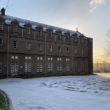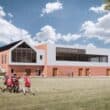
For more than 120 years it stood in the centre of Lurgan as a bank – and never anything else – but the now vacant Danske Bank will take on a new form.
John Aidan Kelly has lodged an application to transform the Market Street building into apartments with part of the ground floor remaining as retail.
The iconic red-brick listed building was put up for sale weeks after Danske Bank pulled the shutters down for the final time.
The entire first and second floors will be transformed from professional, financial use into eight apartments, with the ground floor being partially changed to accommodate two of those living spaces. There will be some external works to provide a new doorway and entrance steps at ground floor level.
A supporting statement outlines how the developer, in this instance, “is mindful of the significant historical value this building retains and its contribution to the wider streetscape of Lurgan”, therefore the proposed changes, brought about as a result of the planning application and Listed Building Consent (LBC) application, are, “in effect, minimal”.
In terms of the overall significance of impact, it is assessed that the proposed works will result in a “minor, insignificant impact on the fabric and setting of the existing building”.
The bank was built at the turn of the 20th Century – approximately 1901 – as the Lurgan branch of the Northern Banking Company, to designs by Belfast-based architect Godfrey William Ferguson (c.1855- 1939).
It is located on a plot previously occupied by a house recorded in the 1890s valuations as the home of a Mary A. Comberton. In or just prior to 1900, as part of an urban improvement scheme, Lurgan’s town commissioners purchased this and several other neighbouring dwellings to the northwest, (the former nos.29-39 Market Street), and all properties situated within ‘Margery’s Lane’, a narrow passage to the southwest.
This area had been deemed ‘unhealthy’ in a report of 1897, prompting the town council to clear it away and make a ‘new street from Market Street to Roger’s Court’ (whose eastern half was roughly along the line of the present Millennium Way).
The Northern Banking Company subsequently acquired the site at the southeastern corner of the new thoroughfare, (soon to be named ‘Carnegie Street’), for £1,600 in 1901, and the new branch was opened in February 1903.
The Northern Banking Company shortened its name to the Northern Bank after being merged with the Midland Bank in 1970, and was acquired by Danske Bank in 2013.
The architectural style of the building, as well as key design features such as scale and massing, have remained the same throughout the lifetime of the building.
The application was lodged with Armagh, Banbridge and Craigavon planners this week and will be publicly advertised in due course.
A decision is expected before summer.





